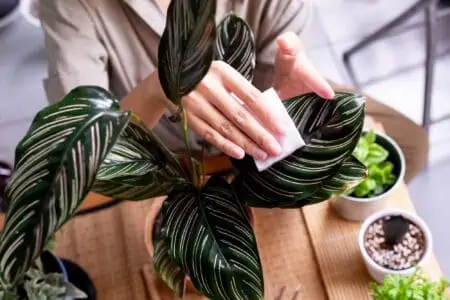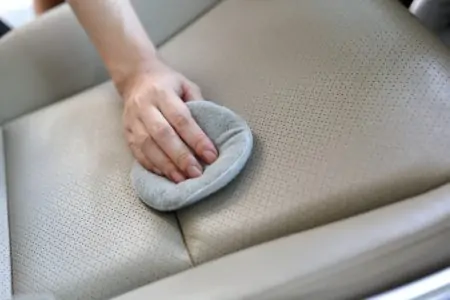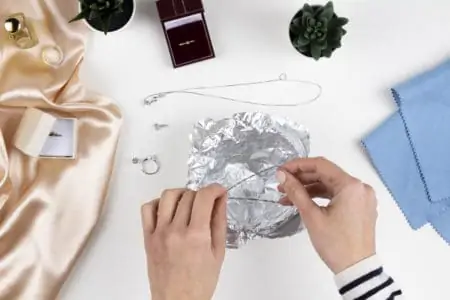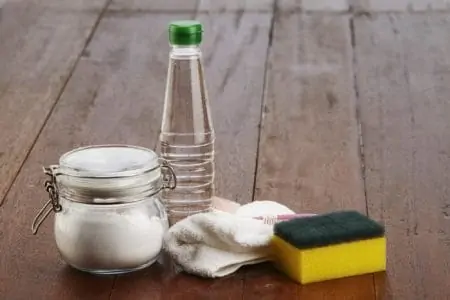Remembering to clean your plant leaves isn’t such an easy task, but it’s important. If your plants aren’t thriving despite being watered and fed, it could be because the leaves are dusty.
Cleaning plant leaves not only keeps them looking good, but it’s vital for their well-being and lifespan.
We’ll show you exactly how to clean plant leaves in the most gentle but effective way for your beloved greenery.
Key Takeaways
- Clean plant leaves regularly to promote healthy growth, prevent pests, and enhance appearance.
- Use water, a cloth, a paintbrush, soap and water, vinegar or lemon juice, or compressed air to clean leaves, depending on the plant type.
- Avoid using coconut oil, olive oil, or baby oil to shine leaves, as it can hinder the plant’s breathing; opt for Neem Oil or Horticultural Oil instead.
- Care for indoor plants by watering correctly, fertilizing, repotting, using insecticides, and maintaining proper temperature and humidity levels.
Should You Clean Plant Leaves?
Yes, removing dust from your indoor plant leaves is essential for many reasons.
First of all, a dusty plant isn’t very aesthetic, and there’s no doubt you brought these plants home to spruce up a room. Removing dust can bring the plants to life and make your home appear cleaner.
Secondly, and most important, debris, dust, and dirt on your leaves can kill them. It blocks sunlight from getting to the plant, slowing down the process of photosynthesis. As a result, your plants won’t grow as well and can become ill or die.
Another important reason is that stressed plants are more likely to attract pests and insects. These can be challenging to remove.
How Often Should You Clean Plant Leaves?
A general rule of thumb is to clean and dust your plant leaves weekly. Another option is to check them and clean them as necessary. To do this, rub the leaf with your thumb.
If you feel or see a layer of dust, no matter how fine, it’s a good idea to clean the plant leaves.
How to Clean Plant Leaves
There are many ways to clean plant leaves. We’ll share six methods. Some are easier than others, but what you choose comes down to personal preference and what products you have to hand.
With Water
The easiest way to clean plant leaves is by using plain water. You can do this either with a spray bottle, in the shower, or by dunking the plants in water.
- Spray: Fill a spray bottle with clean plain water. Spritz the leaves and leave them in direct sunlight for a few hours to dry off.
- Shower: Take the plants to the shower and spray the leaves gently to remove dust and debris. This is an excellent method if you have a lot of dust on the leaves. Let the plant air dry in the shower before moving it back to its spot in the home.
- Dunk: For smaller plants with few blossoms, you can dunk them in hot water. Slowly submerge the whole container and plant, securing the soil, so the plant doesn’t float out. Twirl the plant around, flip it over, then remove it from the sink before letting it air dry.
Top Tip
If the plant seems to be taking a long time to dry, you can wipe the leaves down with a microfiber cloth.
With a Cloth or Duster
You can also use a microfiber cloth or feather duster to clean your plant leaves.
- Wipe: Using either a feather duster or microfiber cloth, gently wipe each individual leaf. Make sure to support the leaf by holding the bottom.
- Dampen: If you want to dampen the cloth for extra cleaning power, submerge it in warm plain water and wring it well. Repeat step one.
- Continue: Continue for each leaf until the plant leaves are spotless.
- For fuzzy leaves: If your plant has fuzzy leaves, you can try a mushroom brush to remove stubborn dust.
With a Paintbrush
A paintbrush can work wonders on smaller plants or plants with more delicate or fuzzy leaves. Think African violets or ferns. Our top tip here is to use a paintbrush size that corresponds best with the size of the leaves.
For instance, for a Maidenhair Fern, use a tiny paintbrush, like a filbert two.
- Find the right paintbrush: Find the best size paintbrush for your leaves.
- Dampen: Dip the paintbrush into warm water. If you are cleaning fuzzy leaves, use a dry paintbrush to avoid embedding the dust further into the leaves.
- Clean: Wipe the leaves clean by ‘painting’ them with a brush. Move slowly and gently, so you don’t damage the leaves. Remember to support the bottom of the leaves with your other hand.
With Soap and Water
For really dirty plants, soap and water are best. If you’ve been away for a few weeks and come home to find that your plants are covered in dust, some of the above methods might not be strong enough. Soap and water will help to lift off the dirt so you can wash it away.
The most important thing to note is to use mild soap. Many people will recommend cleaning with dish soap, but this is not healthy for the plants. Instead, use something non-toxic like Dr. Bronner’s Castile Liquid Soap or WholeNaturals Castile Liquid Soap.
- Make a soapy solution: Mix ¼ teaspoon of soap per quart of water in a bowl or sink.
- Dampen sponge or cloth: Using either a microfiber cloth or a non-abrasive sponge, dampen it in soapy water. Wring it out well.
- Clean the leaves: Wipe down each leaf, supporting it from the bottom. Remove dust, debris, and other dirt. Make sure to swap out the cloth or sponge to avoid transferring dirt.
- Rinse: Once the leaves are clean, spray them or shower them with plain water to remove soapy residue. Then let the plant air dry.
With Vinegar or Lemon Juice
If you want to make a homemade plant cleaner, now’s the time. It’s good to have to hand when you need to clean your leaves with something a little stronger than plain water.
For this, you can use vinegar or lemon juice. The vinegar is successful at keeping pests and pets away from the plants. In contrast, lemon juice is better for removing hard water deposits.
- Create solution: To make either solution, mix one teaspoon of distilled white vinegar or lemon juice per gallon of water.
- Dampen a cloth: Dampen a cloth in either solution and wring it out well.
- Clean: Wipe down each individual leaf gently to remove dirt, debris, hard water stains, or insects. Continue until all the leaves are clean.
- Rinse: Dampen a cloth in plain water and rinse the leaves to remove vinegar or lemon residue.
With Compressed Air
For denser plants, like cacti and succulents, compressed air is best for removing dust and dirt. You can also use water, but some cacti can rot quickly if exposed to too much water. So compressed air can be safer.
- Take them outside: Take the plants outside to an airy spot, so you’re not exposed to excess dust.
- Aim and spray: Aim the compressed air about six inches away from the leaves to avoid damage. Emit the compressed air to remove dust and debris.
How to Clean Different Types of Plants
Not every plant can — or should — be cleaned the same way. If you cleaned a Monstera the same way you cleaned a Fern, it might not be as effective. And if it’s the other way around, you could easily damage your fern.
We’ll walk through each method from above and share what kind of plant it’s best for:
- Spraying with water: It’s safe to spray almost any plant with water. If it’s a more delicate plant with finer leaves, hold the spray bottle further away to avoid damage. For cacti that can’t be soaked, only use a little water.
- Shower: The shower is best for sturdier plants like a Schefflera, Rubber Tree, Monstera, Pilea, or Fiddleleaf. Don’t use this for cacti, as they don’t need excess water.
- Dunking: Dunking is best for smaller plants that like a lot of water. Think Selaginella, String of Hearts, Pothos, Chinese Evergreen, and Coleus. This hack is especially useful when your trailing plants aren’t too long yet, and you can fit them in the sink.
- With cloth or duster: This is a good hack for sturdy plants with larger leaves. We’re talking Fiddleaf, Monstera, Schefflera, Peace Lily, Snake Plant, Macodes Petola Jewel Orchid, and more.
- With a paintbrush: While you can use this hack for literally any plant, the main tip is to use the correct size paintbrush for the leaves. An excellent method for choosing is to get a paintbrush with a head that is as wide as the leaf. This is a great hack for fuzzy-leafed plants like African Violets, Angel’s Hair Artemisia, and Bear Paw Jade. It also works for plants with small delicate leaves, such as Maidenhair Fern, Hoya Linearis, and Asparagus Fern.
- With soap and water: This is suitable for any plant, but make sure you apply it with a tool that won’t injure the plant. A cloth or sponge is fine for bigger plants, but you can apply the soapy water with a paintbrush for smaller or fuzzy plants.
- Vinegar or lemon juice: This is suitable for any plant, but again, use a small paintbrush to apply if the leaves are small or fuzzy.
- Compressed air: We recommend this for denser and sturdy plants such as cacti or succulents.
Can You Use Oil to Shine Plant Leaves?
Here’s what you should know about how to clean houseplant leaves and make them shine.
Many people will recommend coconut oil. While it does make your plants shiny, it can also create a fine, oily layer on your leaves. This can cause more dust and debris to settle on your leaves, making them more difficult to clean later.
Also, because of the layer of oil, the plants will have a more difficult time breathing and making energy. So while it’s okay to use coconut oil once in a while, we don’t recommend making it a habit.
Polishing with olive oil is similar. It will shine your leaves up temporarily, but it can get into the leaves’ pores and prevent them from breathing properly.
Baby oil can also damage your plants. We don’t recommend ever using it.
Instead, try Neem Oil. Not only will it shine up your plants, but it can also deter pests. Always read the manufacturer’s instructions for dilution and application. Avoid using it too much.
Another great option is Horticultural Oil which is designed to make a leaf shine. It won’t burn in the sunlight, either.
Tips For Taking Care of Indoor Plants
Keeping your plants alive is no easy task. Sometimes it can feel like a full-time job. But once you get the hang of it, you’ll find a good rhythm, and your plants will be happy.
Here are some top tips for keeping your plants alive, healthy, tidy, and pest-free:
- Watering: The key to care is by watering correctly. Don’t stick to a schedule; go by what your plants need. Check the top ½ inch of soil and water if it feels dry.
- Fertilize: Houseplants need fertilizer frequently in the spring and summer when they’re doing the most growing. Follow the directions on your chosen fertilizer for the best advice.
- Repot: When the roots of your plants are too long, it’s time to repot the plant into a bigger home. Move up an inch or two at a time.
- Use insecticide: Insecticides, pesticides, or horticulture oil, are great for keeping pests away. Make sure to dilute according to the packaging instructions and keep your hands protected from the solution.
- Place it in the right spot: Usually, when you buy a new plant, it will come with a little label to specify how much light the plant needs. In general, keep them near a window so they can get both direct and indirect sunlight.
- Drainage holes: Make sure the pot you’re using has drainage holes, so the plants aren’t sitting in excess water.
- Get the right humidity level: Most plants are happy in places with 50 percent humidity or higher. Cactus and succulents prefer lower humidity. During the winter, or for those in lower humidity areas, keep your houseplants close together for support.
- Get the right temperature: If your house is too hot, it can damage your plants. The ideal temperature for houseplants is between 65 and 75 Fahrenheit during the day. At night, 10 degrees cooler is best.
- Garlic: Putting a clove of garlic in the plant’s soil can help to deter bugs.
- Mist regularly: Clean your plant leaves and mist your plants regularly.
- Change soil regularly: When you feel your plants need a new lease of life and you’ve ticked all the other boxes, change the top layer of soil. Remove and replace the top ¼ inch of soil.
- Propagate: When a plant is overgrown, or the growth is stunted, propagation can help. Simply find the root of new growth, cut it out, and place it in a jar of water for a few days to further grow the root. Then place it in a new pot.
- Prune: At the end of the summer, when you have a lot of new growth, it’s important to prune. This can prevent the plants from getting too big or too long. Make the cut just above the bud or side shoots so that they grow back. Don’t forget to prune off dead and diseased leaves.












